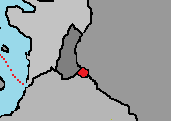Montemera
Montemera City State
| |
|---|---|
|
Flag | |
 | |
| Official languages | Montemeran |
| Government | Unitary Catholic theocratic elective absolute monarchy |
• Sovereign entity | Holy See |
| Marcellinus II | |
| Area | |
• Total | 0.49 km2 (0.19 sq mi) |
| Population | |
• Estimate | 554 |
Montemera, formally known as the Montemera City State is an independent city-state and enclave surrounded by Shoassau, Drambenburg, and Avergnon. The state became an independent entity in 1633 and it is a distinct territory under "full ownership, exclusive dominion, and sovereign authority and jurisdiction" of the Holy See, itself a sovereign entity of international law, which maintains the city state's temporal, diplomatic, and spiritual independence. With an area of 49 hectares (121 acres) and a population of about 553, it is the smallest state in the world by both area and population. Montemera is an ecclesiastical or sacerdotal-monarchical state ruled by the pope who is the bishop of Montemera and head of the Church of Verdusa.
Montemera dates back to Early Christianity and is the principal episcopal see of the Catholic Church, which has approximately 1.329 billion baptised Catholics in the world. The independent state of Montemera, on the other hand, came into existence by the Hessi Treaty between the Holy See and Shoassau in 1633. This de-nationalized the church by setting it aside from the control of any country. During the World War, Drambenburgian forces occupied Montemera but did not directly intervene in the church's functions, allowing Idonus IV to remain pope.
Montemera contains religious and cultural sites, featuring some of the world's most famous paintings and sculptures. The unique economy of Montemera is supported financially by donations from the faithful, by the sale of postage stamps and souvenirs, fees for admission to museums, and sales of publications.